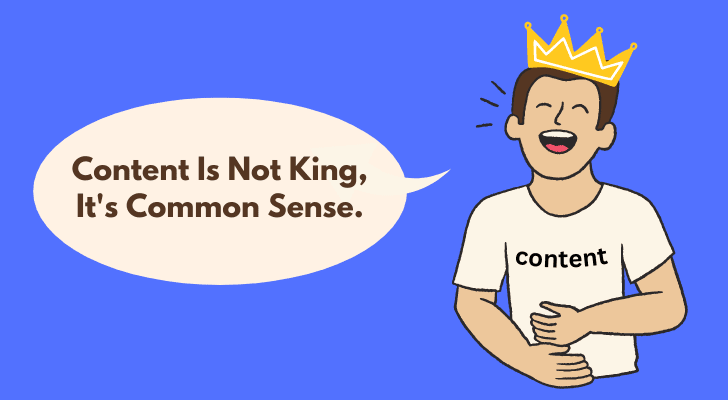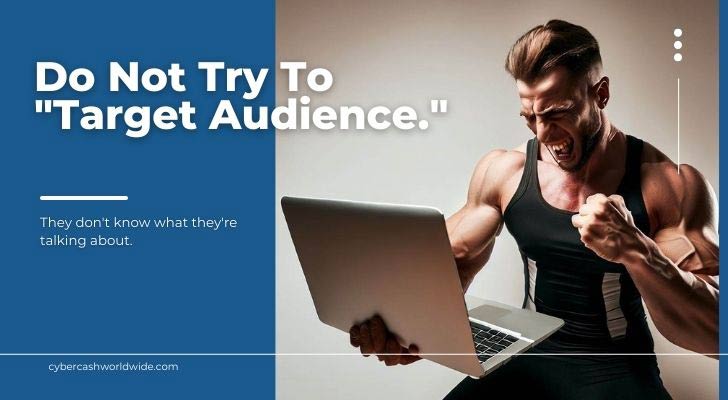Identify your target audience. Define them. How? Use social media. How on social media? Engage with them efficiently. What a load of garbage.
The idea of having a 'target audience' has become so ingrained among how-to guide bloggers that it is almost considered sacrilegious to question its importance. The term 'audience' has lost its meaning and has, unfortunately, become a patronizing term.
The term essentially assumes a passive, almost submissive group of people who are expected to absorb whatever is thrown at them. It has an almost antiquated ring to it, reminiscent of a time when businesses could afford to be condescending and unresponsive to the needs of their customers.
Did You Know?
- Ad Misplacement: Approximately 72% of brands and marketers are concerned about brand content appearing next to inappropriate content, which can alienate the intended audience (Integral Ad Science).
- Ineffective Personalization: 80% of consumers say they are more likely to do business with a company if it offers personalized experiences, but only 22% are satisfied with the level of personalization they receive (Epsilon).
- Lack of Relevance: 33% of marketers admit to not having the right tools for data-driven marketing, leading to less relevant audience targeting (Teradata).
- Low Engagement: Only 14% of consumers feel that the advertisements they see are very relevant, suggesting a disconnect in targeting strategies (Adobe).
- Wasted Ad Spend: It's estimated that wasted digital ad spend due to poor targeting will exceed $50 billion globally by 2022 (WARC).
Audience...The Origin?
The word 'audience' originates from the Latin 'audientia', meaning 'a hearing, listening'. It refers to a group of people who gather to listen or watch something, like a play, a concert, or a movie. But the modern-day consumer is much more than just a passive listener or observer. They are active participants, influencers, and co-creators in the business process.
The ubiquity of social media and online communities has empowered consumers like never before, enabling them to voice their opinions, share their experiences, and influence the perceptions of millions of other people.
The idea of a 'target audience' is based on not only outdated but also ineffective in today's diverse and fragmented world. It presupposes that people can be neatly categorized into homogeneous groups based on superficial criteria such as age, gender, or geographical location.
This kind of simplistic categorization fails to take into account the myriad of other factors that influence a person's preferences, behaviors, and purchasing decisions, such as their cultural background, education, personal experiences, and individual tastes.
The Vagueness of 'Find Your Target Audience'
The advice given by online business 'gurus' often tends to be generic, repetitive, and lacking in practical applicability. "Find your target audience" is a prime example of this kind of advice. It’s a phrase that gets thrown around so often that it almost loses its meaning. What does it even mean to 'find your target audience'? The gurus rarely elaborate beyond surface-level suggestions.
The Generic Advice to 'Use Social Media' and 'Create Valuable Content'
Furthermore, the advice to 'use social media' and 'create valuable content' is so broad that it's almost meaningless. What kind of content is considered valuable? Which social media platforms should one use? How does one effectively use these platforms to reach their 'target audience'? These are just a few of the many questions that arise when trying to implement this advice, and the gurus rarely provide satisfactory answers.

The Frustration of New Business Owners
That kind of advice isn't helpful, in fact, it's incredibly frustrating for new business owners. Because they are looking for concrete, actionable guidance on how to increase net profits. They need to bring down the costs and find ways to widen the profit margin, too. But all they get from those gurus are simply regurgitating the same tired old tips without any real consideration for the difficult challenges faced by new business owners.
Did You Know?
- Misunderstanding Audience Preferences: 45% of consumers will unfollow a brand on social media if their platform content is irrelevant (Sprout Social).
- Ignoring Customer Feedback: Only 10% of European companies are fully engaged with their customers to understand their needs, leading to potential misalignment (Forrester).
- Overlooking Mobile Optimization: 51% of consumers say that a bad mobile experience makes them less likely to engage with a company (Google).
- Underestimating Content Marketing: 70% of marketers lack a consistent or integrated content strategy, leading to potentially misaligned audience targeting (Altimeter).
- Neglecting Email Marketing Segmentation: 39% of marketers do not segment their email lists, which can result in irrelevant messaging (HubSpot).
The Outdated Notion of Targeting and Capturing Customers
The advice also reinforces the outdated idea that businesses should be relentlessly targeting and capturing customers, rather than focusing on creating great products that naturally attract the right audience. It emphasizes external factors that are often beyond your control, rather than internal factors that you can directly influence.
The Uselessness of Generic Advice
So to sum up... Those phrases - 'find your target audience', 'use social media', and 'create valuable content' are generic, repetitive, and lacking in practical applicability. It fails to provide concrete, actionable guidance for new business owners and reinforces an outdated and counterproductive approach to business growth. It’s no wonder that many people find this advice to be utterly useless and frustrating.
The Narrow View of the Market
The process of identifying and targeting a particular audience often inadvertently results in businesses adopting a narrow and myopic view of the market. The method is deeply flawed for several reasons.
The Illusion of Certainty
You often create detailed customer personas to decide who your audiences are. The personas typically include demographic details, psychographic characteristics, and purchasing behaviors. Narrow down the focus to a particular group of people to tailor their products and marketing messages to "meet the needs".
But it's often an illusion of certainty. The "personas" tend to convince yourself that you know exactly who their customers are and what they want. In reality, the market is much more fluid. People's interest change over time, their behaviors change over time, influenced by a variety of factors such as changing social trends, economic fluctuations, and personal experiences. Fucus too narrowly and you risk becoming blind to these changes and may fail to adapt promptly.
Did You Know?
- Failing to Adapt to Changing Audience Needs: 63% of consumers expect personalization as a standard of service, but many brands fail to update their targeting strategies accordingly.
- Inaccurate Data Use: 25% of marketing databases are considered inaccurate, affecting targeting precision.
- Social Media Missteps: 95% of adults aged 18-34 are likely to follow a brand via social networking, yet many brands target this demographic with mismatched content.
- Ignoring Video Content Potential: Video is projected to claim more than 82% of all web traffic by 2021, but only 9% of small businesses leverage YouTube.
- Discounting User-Generated Content: 85% of users find visual user-generated content more influential than brand photos or videos, yet many brands do not incorporate UGC strategies effectively.
The Trap of Confirmation Bias
Confirmation bias is the tendency to search for, interpret, and remember information that confirms one's preexisting beliefs or hypotheses. When you focus on "target audience", you often unconsciously seek out information that confirms their assumptions about that audience, while ignoring or dismissing information that contradicts those assumptions.
For example, a business that has identified 'millennials' as its target audience may focus on research that highlights the importance of sustainability and social responsibility to this demographic while ignoring research that suggests that price and convenience are also significant factors. This can lead to an incomplete and skewed understanding of the market and may result in ineffective marketing strategies and product offerings.
The Risk of Homogenization
Another risk of focusing too narrowly on a specific audience is the tendency to homogenize that audience, treating them as a monolithic group with uniform needs, preferences, and behaviors. This kind of simplistic categorization fails to take into account the diversity and individuality of people within that group.
For example, the 'millennial' demographic includes a wide range of people, from recent college graduates struggling with student debt to successful professionals in their late 30s. By treating them as a single, homogeneous group, businesses may fail to connect with significant segments of that audience and may alienate potential customers with messaging and offerings that do not resonate with their circumstances.
If You Build It, They Will Come
Instead of focusing on finding a target audience, as a new business owner, you should focus on creating great products, and the right people will naturally be drawn to you. Let's explore this theory further.
The Power of Greatness
The fundamental idea behind this theory is that greatness attracts. Whether it is a groundbreaking product, an innovative service, or a unique brand experience, when you focus on creating something truly exceptional, people will naturally be drawn to it.
This approach shifts the focus from external to internal, from trying to fit into existing market demands to creating new demand through innovation and excellence. Instead of trying to please anyone, you should focus on being the best at what you do, and let your work speak for itself.
The Limitations of Targeting
Traditional marketing wisdom suggests that you should identify a target audience and tailor your offerings and messaging to meet the needs and preferences of that audience. However, this approach has several limitations.
- First, it assumes that you can accurately identify and understand your target audience. In reality, people are complex and dynamic, and their needs and preferences are constantly evolving.
- Second, it assumes that the target audience is static and can be neatly categorized into homogeneous groups. In reality, the market is fragmented and diverse, and what appeals to one segment of the audience may not appeal to another.
- Finally, it assumes that by targeting a specific audience, you can effectively capture their attention and loyalty. In reality, people are bombarded with marketing messages from all directions, and capturing and maintaining their attention is increasingly challenging.
Did You Know?
- Overlooking Local SEO: 29% of all Google SERPs contain a local pack in the results, but many businesses do not optimize for local SEO, missing out on local audience targeting.
- Failing at Customer Retention: Acquiring a new customer can be five times more expensive than retaining an existing one, yet retention is often not a focus in targeting strategies.
- Ignoring Privacy Concerns: 87% of consumers say they will take their business elsewhere if they don’t trust a company is handling their data responsibly.
- Underutilizing Analytics: 23% of marketers feel they have a good qualitative, but not quantitative, understanding of their audience segments.
- Not Leveraging AI for Targeting: Only 28% of marketers use AI for product recommendations, missing opportunities for improved targeting efficiency.
The Magnetic Effect of Innovation
Innovation is a powerful magnet that attracts attention and creates demand. When you focus on creating innovative products, you naturally stand out from the crowd and capture people's imagination. This can create a ripple effect, where initial interest and excitement lead to word-of-mouth referrals and organic growth.
For example, when Apple first launched the iPhone, it created a whole new category of mobile devices and revolutionized the way people interact with technology. Apple did not focus on targeting a particular audience; instead, it focused on creating a groundbreaking product that appealed to a broad spectrum of people.
The Word "Audience" Sucks
In light of the above, it is evident that the advice to 'find your target audience' is not only unhelpful but also counterproductive. It is time for online business 'gurus' to stop mindlessly parroting this phrase and to start providing more nuanced, actionable, and individualized guidance to new business owners. The world of business is dynamic and multifaceted, and it demands a more thoughtful and considered approach than simply regurgitating the same old cliches. So, to all the online business 'gurus' out there: it's time to stop saying 'find your target audience' and to start providing real value to your followers.
How I "Finally" Make Over $7,000 Monthly Income
"The most valuable thing I've ever done!"




